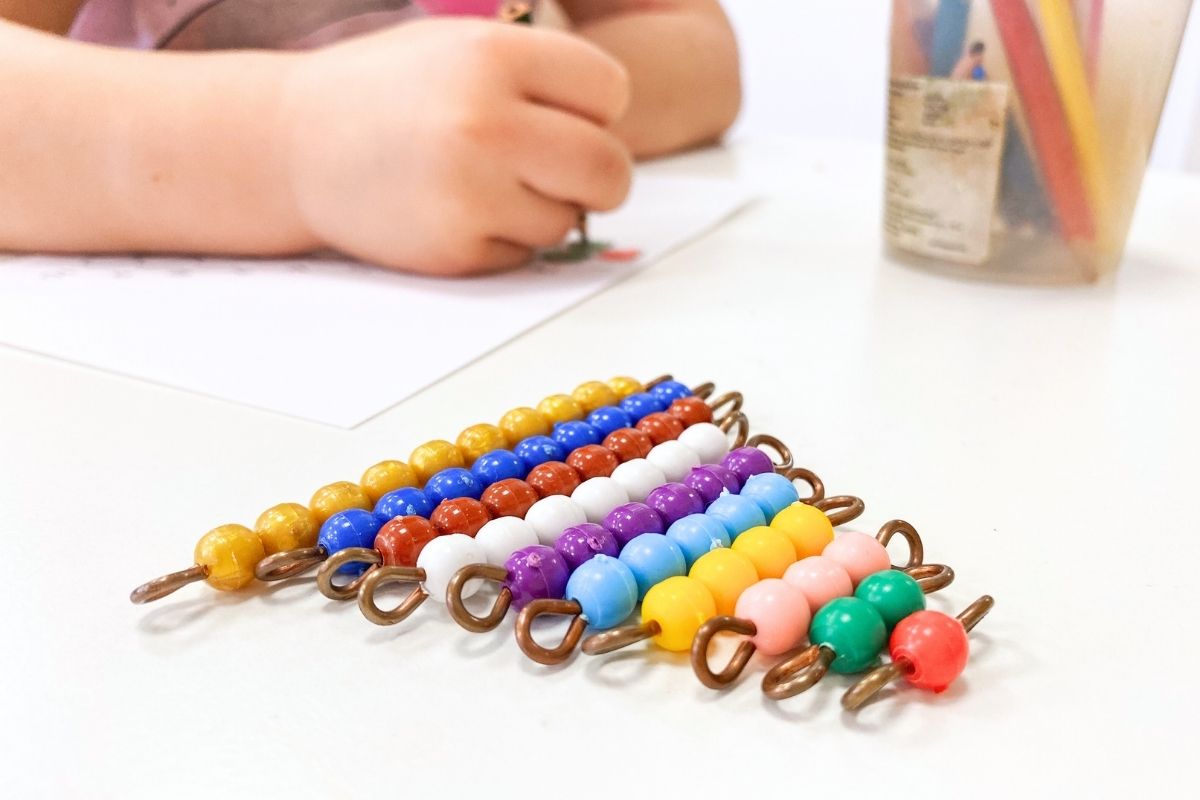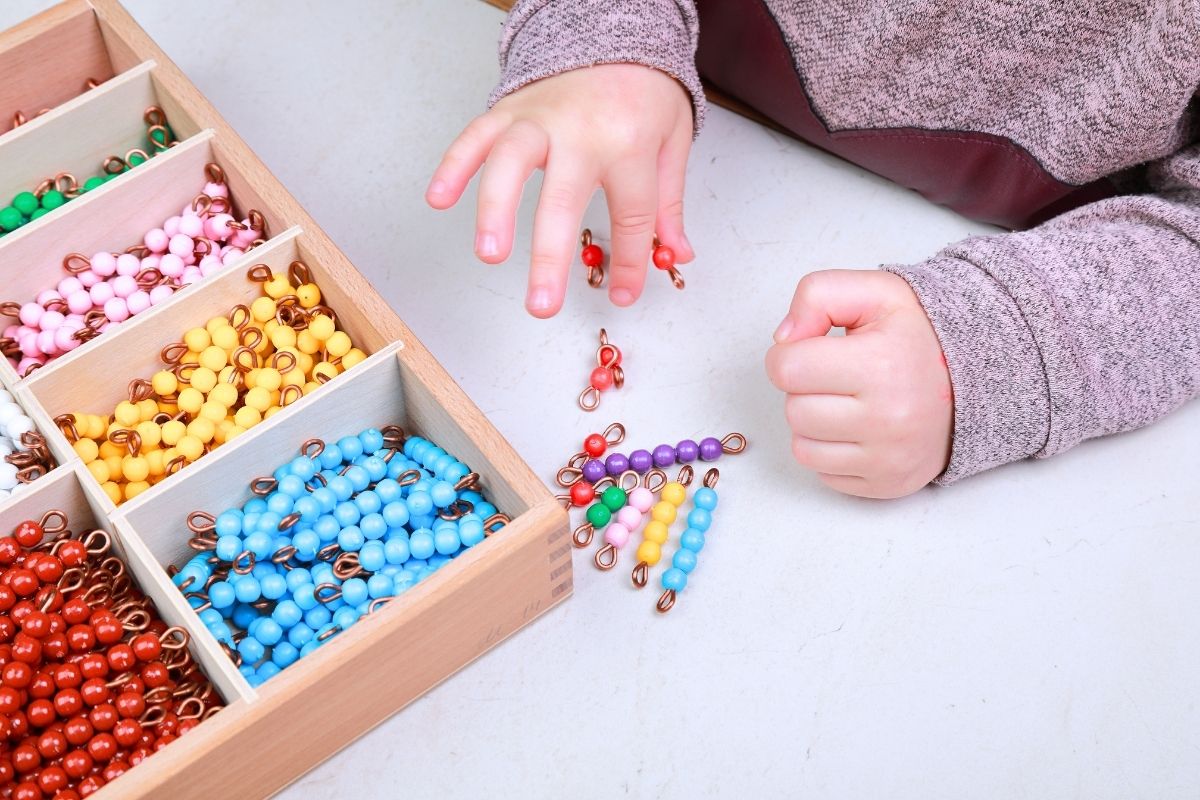Montessori math beads are a collection of bead-based materials designed to help children understand mathematical concepts through hands-on learning. They are integral to the Montessori method, allowing children to visualize and physically interact with abstract numerical ideas.
What is Montessori Beads For Math
Montessori beads for math are tactile learning tools used in the Montessori education system to teach children mathematical concepts. These beads are color-coded and come in various forms, such as bead bars, chains, and squares, each designed to represent different numbers and mathematical operations.
Purpose of Montessori Beads
The primary purpose of Montessori math beads is to transform abstract math concepts into tangible experiences. By allowing children to physically see and touch numbers, they can better understand and internalize mathematical ideas. For instance, a bead bar with three beads visually represents the number three, making it easier for a child to grasp the concept of ‘three.’
Benefits for Children
- Concrete Understanding: Montessori beads offer a hands-on approach, helping children move from concrete to abstract thinking in mathematics.
- Enhanced Engagement: The tactile nature of the beads makes learning more engaging and interactive.
- Visual Learning: The color-coded system aids in memory retention and reinforces number recognition.
- Development of Fine Motor Skills: Handling and counting the beads help improve dexterity and hand-eye coordination.
- Foundation for Advanced Math: The beads lay a strong foundation for understanding more complex mathematical concepts in the future.
Introduction and Structured Learning
In Montessori schools, math beads are integral to the curriculum, especially for children aged 3 to 6. Teachers introduce these beads in a structured manner, starting with basic counting and gradually moving to more advanced arithmetic operations.
Teachers, trained in the Montessori method, begin by introducing children to the simplest bead materials. This typically starts with the individual bead bars, each representing numbers from 1 to 10. Each bead bar has a distinct color, making it easier for children to differentiate and recognize numbers. For instance, a bar with three pink beads represents the number three.
As children become more familiar with these basic counting tools, teachers guide them towards more complex bead materials, such as the golden beads. These are used to teach the decimal system, helping children understand units, tens, hundreds, and thousands. Through hands-on activities, children learn to group these beads, laying the groundwork for addition, subtraction, multiplication, and division.
Best Montessori Beads Materials
Montessori Counting Beads
Counting beads are the foundational blocks of Montessori math. They are typically individual beads that children can touch, feel, and count, making them perfect for introducing the very basics of numbers. By physically handling each bead, children develop a tactile understanding of quantity.
Montessori Golden Beads
The golden beads are instrumental in introducing the decimal system, a foundational concept in arithmetic. These beads, representing units, tens, hundreds, and thousands, provide a hands-on understanding of place value and the base-10 system.
As children work with these beads, they gain insights into number values and relationships. Through structured activities, they can perform various mathematical operations, transforming abstract ideas into tangible experiences. The tactile nature of the beads ensures a multisensory learning approach.
- Units: Individual golden beads, representing the number one.
- Tens: Linear bars composed of 10 golden beads, introducing the concept of a ‘ten’.
- Hundreds: Squares formed by 10 bars of 10 golden beads, visually and tangibly representing a ‘hundred’.
- Thousands: Cubes made up of 10 squares, giving children a solid grasp of what a ‘thousand’ represents.
Montessori Bead Chain
Bead chains are sequences of beads linked together, designed to offer a tactile and visual approach to various mathematical concepts. They serve multiple purposes:
- Linear Counting: By counting each bead in a chain, children practice sequential counting, reinforcing their understanding of number progression.
- Skip Counting: Longer chains, especially those of 100 or 1,000 beads, help children practice counting by tens or hundreds, laying the foundation for multiplication.
- Pattern Recognition: As children work with different bead chains, they begin to recognize patterns and sequences, enhancing their analytical skills.
- Tactile Learning: Handling the bead chains provides a hands-on experience, catering to kinesthetic learners and making abstract concepts more tangible.
- Introduction to Multiplication: By grouping chains, children can visually see how numbers multiply, setting the stage for more advanced arithmetic.
Montessori Long Bead Chain
These extended chains, often reaching up to 1,000 beads, are instrumental in teaching advanced counting. They also introduce children to the concepts of squaring and cubing numbers, as they can see and touch the physical representation of these mathematical operations.
Montessori Bead Chain Arrows
These are essentially markers or labels. When children are counting long bead chains, these arrows help them keep track of their progress. For instance, on a chain of 100 beads, arrows might mark every tenth bead, aiding in skip counting and ensuring accuracy.
Montessori Bead Bars
These color-coded bars, each representing numbers from 1 to 10, are fundamental for arithmetic. By physically adding or removing bead bars, children can visualize and solve problems related to addition, subtraction, multiplication, and division.
| Number of Beads | Color |
|---|---|
| 1 | Red |
| 2 | Green |
| 3 | Pink |
| 4 | Yellow |
| 5 | Light Blue |
| 6 | Mauve (Violet) |
| 7 | White |
| 8 | Brown |
| 9 | Dark Blue |
| 10 | Golden (Dark Yellow) |
Montessori Bead Stairs
The colored bead stair is a vibrant tool that makes learning numbers a visual delight. Each number from one to ten is represented by a distinct color, enabling children to link numbers with particular hues, thereby boosting their recall and identification skills.
This activity not only helps the child associate the quantities 1 through 9 with their numerals but also familiarizes them with materials used in advanced Montessori math activities such as the teens beads, teens board, short chains, long chains, and bead bar arithmetic operations like addition, subtraction, and multiplication.
Montessori Bead Cabinet
The Montessori bead cabinet, more than just a storage unit, is a thoughtfully crafted educational tool. Housed within the cabinet are various bead materials, each playing a distinct role in teaching mathematical concepts. From individual beads to long chains, squares, and cubes, each compartment of the cabinet is dedicated to a specific set of bead materials. The organization is not arbitrary; it’s designed to reflect the hierarchy and relationships of numbers in the decimal system.
Montessori Checkerboard
Specifically designed for multiplication, the Checkerboard uses colored beads to represent units, tens, hundreds, etc., allowing children to visually and tangibly work with larger multiplication problems.
How To Use And Introduce Montessori Math Beads for Different Age Groups
The Montessori math beads are versatile tools that cater to various developmental stages. Here’s how educators and parents can introduce and engage children with these materials, tailored to their age and learning needs:
For Toddlers (Ages 2-3)
- Material: Colored Bead Bars
- Purpose: To introduce them to the world of numbers.
- Setting: A serene environment with a low table and a floor mat is ideal.
- Engagement: Spread out the bead bars in sequence. As you count aloud, point to each bead. Encourage the child to replicate your actions, allowing them to touch, feel, and count along.
For Preschoolers (Ages 4-5)
- Material: Golden Beads (Units, Tens)
- Purpose: To acquaint them with the foundational concepts of the decimal system.
- Setting: A spacious area with a table or floor mat works best.
- Engagement: Begin with the individual beads, representing ‘units.’ Gradually move to the 10-bead bar, symbolizing ‘ten units.’ Group and count the beads together. Guide them through rudimentary addition or subtraction tasks.
For Early Elementary Students (Ages 6-8)
- Material: Bead Chains and Bead Bars
- Purpose: To reinforce numerical sequencing and basic arithmetic skills.
- Setting: A larger table space is required, especially for laying out bead chains.
- Engagement: Showcase skip counting using bead chains. Use bead bars to visually demonstrate addition or subtraction. Engage their curiosity by asking them to display specific bead bars or combine them for arithmetic tasks.
For Upper Elementary Students (Ages 9-12)
- Material: Bead Frame and Advanced Bead Chains
- Purpose: To delve into advanced mathematical operations and provide a visual understanding of multiplication.
- Setting: A desk or table setup is suitable for these advanced materials.
- Engagement: Employ the bead frame for intricate calculations. Use advanced bead chains to visually depict multiplication. Encourage independent problem-solving and challenge them with multiplication exercises to solidify their understanding.
| Age Group | Material | Purpose | Setting | Activities |
|---|---|---|---|---|
| Toddlers (Ages 2-3) | Colored Bead Bars | Introduction to numbers | Quiet space with low table & floor mat | Lay out bead bars, count aloud, encourage mimicry and tactile exploration. |
| Preschoolers (Ages 4-5) | Golden Beads (Units, Tens) | Introduction to the decimal system | Spacious area with table or floor mat | Start with ‘units’, progress to ‘tens’, group and count beads, guide through basic arithmetic. |
| Early Elementary (Ages 6-8) | Bead Chains, Bead Bars | Numerical sequencing & basic arithmetic | Larger table space | Demonstrate skip counting, visually represent addition/subtraction, ask to show or combine bead bars. |
| Upper Elementary (Ages 9-12) | Bead Frame, Advanced Bead Chains | Advanced mathematical operations & multiplication visualization | Desk or table setup | Use bead frame for complex tasks, represent multiplication visually, encourage independent problem-solving. |
Integration with Other Montessori Materials
Montessori math beads, while powerful on their own, truly shine when integrated with other Montessori materials. The beauty of the Montessori method lies in its interconnectedness, where each material complements and builds upon the other.
Take the number rods, for instance. These rods visually represent quantities and can be paired with the math beads to combine the concept of quantity with numeral recognition. A child can match a bead bar of seven beads with the number rod representing seven, solidifying both the numeral and its quantity in their mind.
Similarly, the hundred board, which emphasizes sequence and order, can be used alongside bead chains for skip counting exercises, allowing children to see patterns and sequences in a tactile manner.
By integrating the math beads with these and other Montessori materials, educators can provide a comprehensive and holistic math education that addresses various learning styles and paves the way for deeper mathematical understanding.
| Montessori Material | Description | How It Complements Math Beads |
|---|---|---|
| Number Rods | Wooden rods that represent quantities from 1 to 10. | Paired with bead bars to combine numeral recognition with the concept of quantity. |
| Hundred Board | A board with 100 squares, numbered from 1 to 100. | Used alongside bead chains for skip counting and recognizing patterns. |
| Spindle Box | A box with compartments labeled 0 to 9, and spindles for counting. | Children can match the number of spindles to the corresponding bead bar, reinforcing number quantities. |
| Sandpaper Numbers | Numbers made from sandpaper for tactile learning. | Children can trace sandpaper numbers and then count the corresponding bead bar, linking touch with quantity. |
| Bead Frame | An abacus-like tool for arithmetic operations. | Enhances arithmetic understanding when used with bead bars for addition, subtraction, multiplication, and division. |










